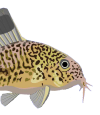JoolsAbstract wrote:
can modify its typically bunocephalid or aspredinid-catfish shape, hiding many of its features including all of its fins, so that it resembles a large bean or seed of the spermatophyte family Leguminosae or Fabaceae. This is accomplished mainly by adpressing both pectoral fins and folding the tail and caudal fin tightly around one side of the body and head. In so doing, Amaralia radically transforms itself from the bilaterally symmetrical form of a vertebrate animal into the radially symmetrical form of a seed. The fish then remains motionless until it unfolds itself. While mimicry of plant parts and camouflage to resemble plants or woody background is well known in fishes, mimicry of a seed apparently has not been reported previously. It possibly facilitates prey capture by Amaralia, which feed on the large yolky eggs of orally-brooding or otherwise parentally-guarding loricariid catfishes. It might also be involved in predator avoidance. Mimicry and camouflage involving vegetation is now known in a wide variety of freshwater and marine fishes.
Mimicry of a Bean Seed by the Amazonian Aspredinid Catfish Amaralia hypsiura (Kner 855) [sic]
- Jools
- Expert
- Posts: 16280
- Joined: 30 Dec 2002, 15:25
- My articles: 198
- My images: 941
- My catfish: 237
- My cats species list: 88 (i:13, k:2)
- My BLogs: 7 (i:10, p:167)
- My Wishlist: 23
- Spotted: 451
- Location 1: Middle Earth,
- Location 2: Scotland
- Interests: All things aquatic, Sci-Fi, photography and travel. Oh, and beer.
- Contact:
Mimicry of a Bean Seed by the Amazonian Aspredinid Catfish Amaralia hypsiura (Kner 855) [sic]
Mimicry of a Bean Seed by the Amazonian Aspredinid Catfish Amaralia hypsiura (Kner 855)[sic]
Owner, AquaticRepublic.com, PlanetCatfish.com & ZebraPleco.com. Please consider donating towards this site's running costs.





